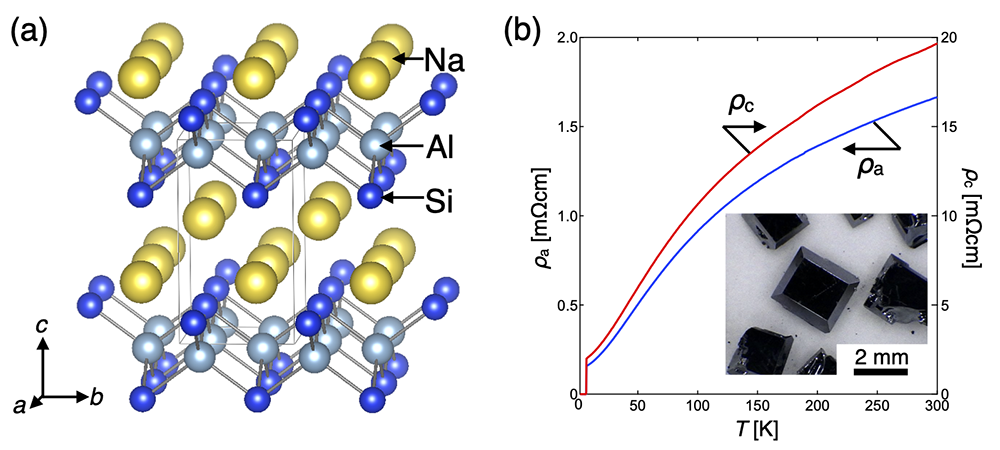PC3-1-INV
Single crystal growth and characterization of an sp electron superconductor NaAlSi with topological nodal lines
*Takahiro Yamada1
- Institute of Multidisciplinary Research for Advanced Materials, Tohoku University1
NaAlSi is an sp electron superconductor that crystallizes in an anti-PbFCl-type layered structure with a transition temperature Tc of approximately 7 K as shown in Fig. 1(a) [1–3]. Recently, electronic state calculations predicted topological nodal lines in the semimetallic band structure, and the relation between the topological property and superconductivity has attracted much attention [3–5]. However, experimental information on the superconducting and normal states of NaAlSi is limited mainly because all experiments have been performed on polycrystalline samples. In the present study, we successfully prepared NaAlSi single crystals using an Na–Ga flux method and characterized their superconducting and normal-state properties using electrical resistivity, magnetization, and heat capacity measurements [6].
The grown single crystals of NaAlSi had a square-plate-like shape with (001) facets that were 1–4 mm wide and 0.1–0.5 mm thick. The electrical resistivities of the single crystals along the a-axis (ρa) and c-axis (ρc) are 1.66 and 19.7 mΩ cm, respectively, at 300 K, and show an anisotropy factor of 12, which is probably caused by the two-dimensionality of the electronic structure [Fig. 1(b)]. Both electrical resistivities decrease gradually upon cooling and decrease abruptly at 7.2 K, reaching zero below 6.8–6.9 K. The zero-resistance temperatures are in good agreement with the intrinsic Tc of 6.8 K determined from a jump in the heat capacity associated with the superconducting transition. The analysis of the heat capacity data in the low-temperature region suggests that NaAlSi has an anisotropic superconducting gap. The Sommerfeld coefficient (γexp = 2.17 mJ K−2 mol−1) estimated from the heat capacity and the magnetic susceptibility (Pauli paramagnetism, χP = 6.1 × 10−5 cm3 mol−1) both exceed the values expected from the electronic state calculation, resulting in a Wilson ratio of 2.0, which is typical for strongly correlated electron systems. Additionally, NaAlSi exhibits a T2 resistivity at low temperatures under a magnetic field of 4 T applied along the c-axis in the normal state. These results strongly indicate that, despite the sp electron system, the normal state of NaAlSi is governed by the electron correlations and the superconductivity is not attributed to a simple phonon mechanism but involves a certain unconventional aspect.
References
1) S. Kuroiwa, H. Kawashima, H. Kinoshita, H. Okabe, and J. Akimitsu, Physica C 466, 11 (2007).
2) L. Schoop, L. Müchler, J. Schmitt, V. Ksenofontov, S. Medvedev, J. Nuss, F. Casper, M. Jansen, R. J. Cava, and C. Felser, Phys. Rev. B 86, 174522 (2012).
3) H. B. Rhee, S. Banerjee, E. R. Ylvisaker, and W. E. Pickett, Phys. Rev. B 81, 245114 (2010).
4) L. Muechler, Z. Guguchia, J. C. Orain, J. Nuss, L. M. Schoop, R. Thomale, and F. O. von Rohr, APL Mater. 7, 121103 (2019).
5) L. Jin, X. Zhang, T. He, W. Meng, X. Dai, and G. Liu, J. Mater. Chem. C 7, 10694 (2019).
6) T. Yamada, D. Hirai, H. Yamane, and Z. Hiroi, J. Phys. Soc. Jpn. 90, 034710 (2021).
Fig 1. Crystal structure (a) and electrical resistivity of NaAiSi (b). Inset is grown single crystals.
Keywords: superconductivity , single crystal growth, topological nodal-line semimetal, electron correlations
